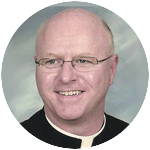
Msgr. Joseph Prior
(See the readings for the Epiphany of Our Lord, Jan. 2)
The fifth-grade teacher was working diligently with one particular student. He was having difficulty grasping a particular mathematical formula. She spent hours with him after school trying to help him understand. Step by step, example by example, she would go through the lesson. Finally, it all came together and he understood.
A few days later, the teacher asked the youth what had happened: “What pulled it all together?” He said, “I’m not sure, it was as if all of a sudden a light went on in my head and I could see all how all the parts came together.”
The experience is a common one for people of all ages when they are trying to learn something new that might be challenging. The “light” image is something we hear frequently this time of the year in a different but related way. The image is one used for Jesus, the Christ. He is the “Light of the World.”
[tower]
During the Christmas season we use lights on our trees, houses and neighborhoods. The lights are to remind us of the Light. St. John in the Fourth Gospel uses the image to describe Jesus’ confrontation with evil. In the prologue he writes: “The light shines in the darkness and the darkness has not overcome it.”
Jesus is also the one who brings light to those in darkness. This was most vividly described in John’s telling of Jesus’ healing the man born blind. Jesus’ bringing light also occurs in his teaching. In revealing the Father he pulls everything together and invites his listeners to enter into the light.
The “light” image has a part in today’s celebration of the Epiphany. Interestingly, the word “epiphany” has come into popular use in the English language to describe something like the story mentioned above. Webster’s dictionary describes it as “a moment in which you suddenly see or understand something in a new or very clear way.”
The magi follow a star that shines above them. The star gives off light that they can see from afar. Once they arrive in Bethlehem and find the “Light,” the star disappears. That particular light was to draw them to the Christ.
The magi represent the gentiles (non-Jews) as the shepherds represent the people of the covenant (Jews). Together they represent all of humanity who are invited to the light by the Light. Jesus is a child of the covenant and God’s relationship with Israel prepared his way. Now at the beginning of his life on earth, we see that he comes not just for the Jewish people but for all peoples.
In him all nations will find a home. Isaiah writes: “Rise up in splendor, Jerusalem! Your light has come, the glory of the Lord shines upon you. See darkness covers the peoples; but upon you the Lord shines, and over you appears his glory. Nations shall walk by your light, and kings by your shining radiance. Raise your eyes and look about; they all gather and come to you.”
The celebration of the Epiphany affords us the opportunity to encounter the Light who is Jesus, the Christ. Many people have been disoriented in a wide variety of ways in the past two years as an effect of the coronavirus situation and all its varied implications on life. Questions arise that were never asked before.
People have found themselves confronting fear, frustration, loneliness, anxiety, uncertainty and so on. Many have described this using the term “darkness.” Many are looking for an “epiphany.”
The magi remind us that Jesus is here and once we find him the “light bulb” goes on, the darkness begins to dissipate and we find ourselves in the Light.
***
Msgr. Joseph Prior is pastor of Our Lady of Grace Parish, Penndel, and a former professor of Sacred Scripture and rector of St. Charles Borromeo Seminary.



Share this story